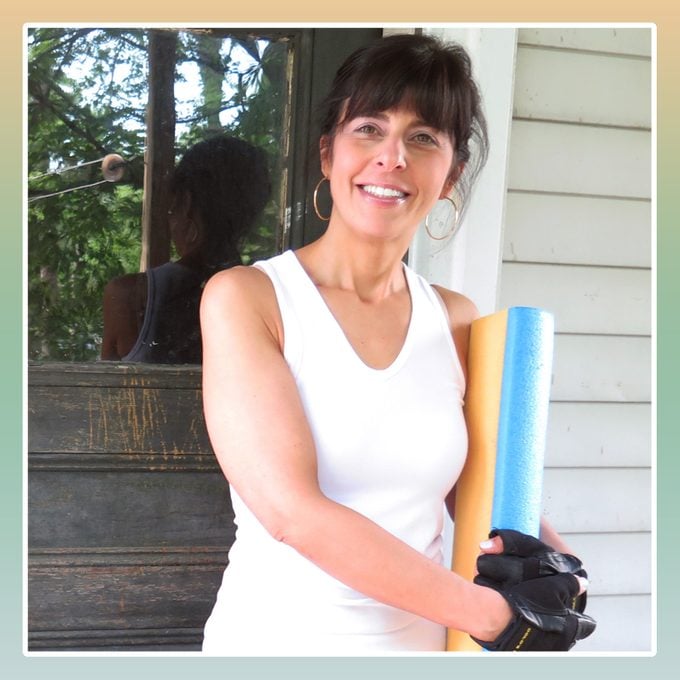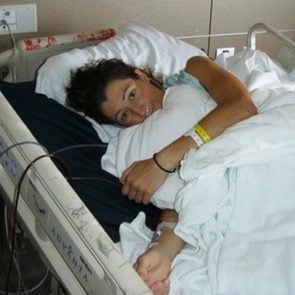I Needed Surgery for My Sciatica—but I Found Natural Pain Relief Instead
Updated: Mar. 09, 2021
After a horseback riding accident, Charlene Bazarian was supposed to get spinal fusion surgery to relieve her sciatica pain. Here's how she found a natural solution to her agony.

Up to 40 percent of people will experience sciatica, a condition in which the sciatic nerve is compressed or impacted, in their lifetime. While the problem occurs in the lower back, pain can extend down through the backs of the legs and can quickly become unbearable. If the sciatica is caused by a herniated or bulging disc, surgery may be offered as a solution. In fact, it was the only solution Charlene Bazarian was given when she saw four orthopedic surgeons about her debilitating pain. Instead, she resolved to find a holistic treatment. Here’s, how she found sciatica pain relief through movement.
Living with sciatica pain
I’m not sure exactly when the pain started. I had a bad horseback riding accident many years ago that took a while to heal and I don’t think I was ever the same afterward. Over time, the bones of my spine started to compress on my sciatic nerve, which starts in the lower back and runs down the legs, and it began to cause pain that got progressively worse.
Around four or five years ago, it got to the point where the pain was really unmanageable. If I stood for too long or sat for too long I would get stabbing, shooting pain down my left leg, from the back of my thigh all the way down to my ankle. There were times when I would walk just 10 feet and I’d start to feel my leg going numb.
I remember around that time, I took my kids to the Christmas parade in my town. While we were standing watching the parade I had to lean against the wall of the CVS we were in front of because the pain was so bad that I couldn’t stand up straight. Another time, I went out for dinner with friends. The chairs were a bit low and we sat and talked and ate for a while. By the time I got up, my legs were completely numb and I was afraid I was going to fall walking out of the restaurant.
[Here’s how one woman’s leg pain turned out to be cancer.]
Looking for a lifelong fix
I saw four different orthopedic surgeons in an attempt to see what was going in my back. They all wanted to do a full spinal fusion surgery in order to release the pressure off of the L4 and L5 discs that were being compressed. But the recovery from the surgery was brutal—six months of not being able to lift anything, not even a gallon of milk. I was taking care of my elderly mother, raising three kids, and working for myself: I couldn’t afford to be out of commission for that long.
One doctor suggested cortisone shots. I did get one to take the edge off, but I didn’t want to continue with those. I’d just turned 50 and wanted to give myself somewhere to go in the future. I figured if I started doing regular shots then, what would I do when I was older?
Others offered different pain medications to try, but I was hesitant. I didn’t just want to feel better, I wanted to be better. I wanted to fix whatever was causing my pain, not just mask it.
One of the surgeons I met with was a friend of a friend. He reviewed my case and gave me his honest opinion: While surgery might help, it wasn’t a lifelong fix. There was a good chance that after five years my pain levels would be back to what they were pre-surgery. Giving up six months of recovery and then being back to square one after five years? That wasn’t going to work for me.
Experimenting with holistic treatments
I decided to start experimenting with holistic treatments to make the pain more manageable. I saw a chiropractor who offered acupuncture and cupping, a treatment where cups are placed on the skin that use suction to bring healing blood flow to the area. Cupping in particular was interesting and I found it really helpful—I felt like it was releasing the pressure in my lower back and allowing the inflammation that was causing my pain to go down.
Finding sciatica pain relief through movement
A rheumatoid arthritis doctor I saw recommended that I try Gyrotonic classes and referred me to a studio where I could take them. It kind of looks like Pilates but it’s a different method that uses different machines. The focus was on articulating my spine and creating space by moving in ways that are not your normal range of motion. One machine felt like stirring a large pot and there were others where I would twist in different ways.
I exercised quite a bit at the time—having lost 100 pounds previously, I was determined to keep it off, and exercise was a big part of that. The Gyrotonic classes used muscles I had never used before. It was a totally different way of strengthening my core and creating space for my spine and it made a huge difference.
I also used foam rollers and exercise balls with little nubs on them to massage my back and take some of the pressure off.
[Here are recommended stretches for sciatica pain relief.]
I finally found a long-term solution
After a few months, the pain began to gradually improve and eventually disappeared. I never went back to the orthopedic surgeons who suggested a spinal fusion. These days, I never get the stabbing, burning, down-the-leg pain that I had five years ago. Sometimes, if I go for a 45-minute walk on hard pavement or if I’m wearing the wrong shoes, I will start to get a numb feeling that tells me I shouldn’t be doing that.
My goal at this point is to maintain stability and try not to do anything that poses a risk of causing pain. For example, I bike instead of walk and do more low-impact strength training than high-impact jumping around.
Up until the start of the pandemic, I would occasionally get a cupping or an acupuncture treatment as a sort of tune-up, but I haven’t been since and I’ve felt good. I still use the foam roller every day. It helps maintain the space in my spine that prevents the pressure and pain from returning.
When I’m talking to people through my website or my Facebook page, FBJ Fit, I’m always saying that people can push themselves farther than they think they can. I believe that, but I also believe it’s important to minimize risk and do what feels good for you, which is what I do when it comes to my back. I set out to find a lifelong fix that didn’t involve cutting me open and putting metal pieces in my spine and I think I found one!
—As told to Alyssa Sybertz



